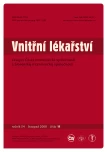Hypoglycaemic periodic paralysis in hyperthyroidism patients
Authors:
J. Kratochvíl; J. Masopust; V. Martínková; J. Charvát
Authors place of work:
Jednotka intenzivní metabolické péče Interní kliniky 2. lékařské fakulty UK a FN Motol Praha, přednosta prof. MUDr. Milan Kvapil, CSc., MBA
Published in the journal:
Vnitř Lék 2008; 54(11): 1100-1101
Category:
Kazuistika
Summary
Hypokalemic periodic paralysis (HPP) is a rare disorder characterised by acute, potentially fatal atacks of muscle weakness or paralysis. Massive shift of potassium into cells is caused by elevated levels of insulin and catecholamines in the blood. Hypophosphatemia and hypomagnesemia may be also present. Acidobasic status usually is not impaired. HPP occurs as familiar (caused by ion channels inherited defects) or acquired (in patients with hyperthyroidism). On the basis of two clinical cases we present a review of hypokalemic periodic paralysis in hyperthyroid patients. We discuss patogenesis, clinical and laboratory findings as well as the principles of prevention and treatment of this rare disorder.
Key words:
hyperthyroidism – hypokalemia – hypokalemic periodic paralysis
Zdroje
1. Fontaine B et al. Periodic paralysis and voltage-gated ion channels. Kidney Int 1996; 49 : 9–18.
2. Ober KP. Thyrotoxic periodic paralysis in the United States. Report of seven cases and review of the literature. Medicine (Baltimore) 1992; 71 : 109.
3. Manoukian MA, Foote JA, Crapo LM. Clinical and metabolic features of thyrotoxic periodic paralysis in 24 episodes. Arch Intern Med 1999; 159 : 601–606.
4. Kung AW et al. Association of novel single nucleotide polymorphisms in the calcium channel alpha 1 subunit gene (Ca(v)1.1) and thyrotoxic periodic paralysis. J Clin Endocrinol Metab 2004; 89 : 1340–1345.
5. Ptacek LJ et al. Dihydropyridine receptor mutations cause hypokalemic periodic paralysis. Cell 1994; 77 : 863–868.
6. Wang Q et al. Novel CACNA1S mutation causes autosomal dominant hypokalemic periodic paralysis in a Chinese family. J Mol Med 2005; 83 : 203–208.
7. Sternberg D et al. Hypokalaemic periodic paralysis type 2 caused by mutations at codon 672 in the muscle sodium channel gene SCN4A. Brain 2001; 124 : 1091.
8. Ko GT et al. Thyrotoxic periodic paralysis in a Chinese population. QJM 1996; 89 : 463–468.
9. Chan A et al. In vivo and in vitro sodium pump activity in subjects with thyrotoxic periodic paralysis. BMJ 1991; 303 : 1096–1099.
10. Wu CC et al. An unrecognized cause of paralysis in ED: thyrotoxic normokalemic periodic paralysis. Am J Emerg Med 2003; 21 : 71–73.
11. Kim JB, Lee KY, Hur JK A. Korean family of hypokalemic periodic paralysis with mutation in a voltage-gated calcium channel (R1239G). J Korean Med Sci 2005; 20 : 162–165.
Štítky
Diabetológia Endokrinológia Interné lekárstvoČlánok vyšiel v časopise
Vnitřní lékařství

2008 Číslo 11
- Rizikové období v léčbě růstovým hormonem: přechod mladých pacientů k lékařům pro dospělé
- Statiny indukovaná myopatie: Jak na diferenciální diagnostiku?
- Parazitičtí červi v terapii Crohnovy choroby a dalších zánětlivých autoimunitních onemocnění
- Hydroresponzivní krytí v epitelizační fázi hojení rány
- Co dělat při intoleranci statinů?
Najčítanejšie v tomto čísle
- Hypokalemická periodická paralýza u pacientů s hypertyreózou
-
Histiocytóza z Langerhansových buněk u osob dospělého věku – nemoc s mnoha tvářemi.
Zkušenosti jednoho pracoviště a přehled projevů nemoci - Bezpečnost dlouhodobého podávání losartanu v běžné klinické praxi: neintervenční studie NCT-CZ 14/04/LOZ
- Význam stanovování inhibinu B v klinické andrologické praxi
